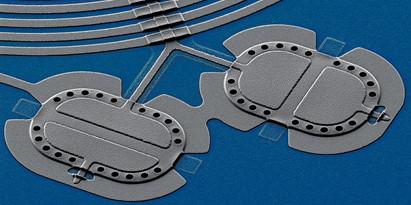NIST Team Directs and Measures Quantum Drum Duet
Researchers at the National Institute of Standards and Technology (NIST) have “entangled” two small mechanical drums and precisely measured their linked quantum properties. Similar entangled pairs may someday perform computations and transmit data in large-scale quantum networks.
The NIST team, which was led by physicist John Teufel, used microwave pulses to entice the two tiny aluminum drums into a quantum version of the Lindy Hop, with one partner bopping in a cool and calm pattern while the other was jiggling a bit more. Researchers analyzed radar-like signals to verify that the two drums’ steps formed an entangled pattern—a duet that would be impossible in the everyday classical world, according to a NIST press release.
Highly entangled, massive quantum systems ultimately might serve as long-lived nodes of quantum networks. The high-efficiency radar measurements used in the work could be helpful in applications such as quantum teleportation—data transfer without a physical link—or swapping entanglement between nodes of a quantum network, because such applications require decisions to be made based on measurements of entanglement outcomes. Entangled systems could also be used in fundamental tests of quantum mechanics and force sensing beyond standard quantum limits, the press release explains.
What’s new, NIST says, is not so much the duet itself but the researchers’ ability to measure the drumbeats, rising and falling by just one-quadrillionth of a meter, and verify their fragile entanglement by detecting subtle statistical relationships between their motions.
Quantum mechanics was originally conceived as the rulebook for light and matter at atomic scales. However, in recent years researchers have shown that the same rules can apply to increasingly larger objects such as the drums. Their back-and-forth motion makes them a type of system known as a mechanical oscillator. Such systems were entangled for the first time at NIST about a decade ago, and in that case the mechanical elements were single atoms.
Since then, Teufel’s research group has been demonstrating quantum control of drum-like aluminum membranes suspended above sapphire mats. By quantum standards, the NIST drums are massive, 20 micrometers wide by 14 micrometers long and 100 nanometers thick. They each weigh about 70 picograms, which corresponds to about 1 trillion atoms.
Entangling massive objects is difficult because they interact strongly with the environment, which can destroy delicate quantum states. Teufel’s group developed new methods to control and measure the motion of two drums simultaneously. The researchers adapted a technique first demonstrated in 2011 for cooling a single drum by switching from steady to pulsed microwave signals to separately optimize the steps of cooling, entangling and measuring the states. To rigorously analyze the entanglement, experimentalists also worked more closely with theorists, an increasingly important alliance in the global effort to build quantum networks.
The NIST drum set is connected to an electrical circuit and encased in a cryogenically chilled cavity. When a microwave pulse is applied, the electrical system interacts with and controls the activities of the drums, which can sustain quantum states like entanglement for approximately a millisecond, a long time in the quantum world.
The research is described in the May 7 issue of Science.
For more on quantum research, read:
Prepare National Security Systems Now for Quantum Threats
Quantum Technologies Suit Up for the Battlefield
Quantum Information Science Matters





Comments